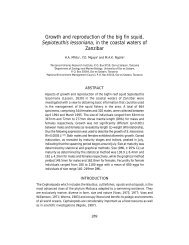Population covered by sewerage infrastructure. The population of Mombasa served bywater-borne sewerage is 15% (Mwaguni and Munga, 1997). In another study conducted byBambra 1997/8, the figure quoted is 10% as reported in the Sanitation StakeholderConsultation Workshop Document of the Mombasa Experience (UNDP – World Bank, Waterand Sanitation Program September 1998). On average therefore, only 12-13 % of thepopulation is served by the water-borne sewerage network. The decrease is explained by therapid population growth in areas outside the coverage of the system and the limited extensionof the systems itself. In terms of area covered, only one third of the city of Mombasa Islandis connected to water-borne sewerage. Except in some parts of Changamwe, the rest of theremaining Divisions of the District are not sewered. However, the situation is expected toimprove in the very near future when the expansion and re-design of the sewerage system iscompleted to serve the whole of Changamwe Division. This will significantly increase both thepercentage of population and the area covered by the sewerage infrastructure.Existing Wastewater Management Infrastructure. There are two treatment plants that werebuilt to serve specific areas of the District. One is located on Mombasa Island and the otherin Changamwe Division. The treatment plant on the Island has been out of use for manyyears, and domestic wastes from the sewered population enter the marine environmentuntreated. The plant in Changamwe has also been out of use for a long time, has since beenre-designed and is now under construction to serve a larger population. This plant, to becommissioned soon, will greatly improve the sewage management in Mombasa. For the restof the population, the management of human wastes is by the use of pit latrines and septictank-soakage pit systems. 15% the population relies on septic tank/soakage pit system while72% use pit latrines. The responsible authorities are over-strained and under-funded andcannot provide regular emptying services to the rapidly growing urban population and who aretherefore left to cope with unsanitary practices. Tourist hotel establishments use septic tanksoakagepit systems for human wastes, although some of them have installed their ownsewage treatment plants.Main Point Sources of Pollution (Domestic, Industrial, Ports)The following are the locations concentrating industrial and domestic uses generatingsewage:• Old Town for mainly domestic sewage• Ziwani, Tononoka and Ganjoni residences are illegally connected to the stormwaterdrains using them for domestic sewage waste discharges,• Changamwe for both domestic and industrial wastes• Shimanzi are for industrial wastesThe main discharge areas receiving pollution loads from industrial, domestic and portactivities are:• In Tudor Creek, the point sources of pollution are Mombasa Hospital, Tamarind, OldTown, Coast General Hospital, Mombasa Polytechnic, and Tudor Estate. These sourcesdischarge raw sewage and hospital waste of unknown composition.• In the Mtwapa Creek the point source of pollution is the Shimo La Tewa GK Prison,which largely discharges wastes of human origin.• The sewage out-falls at Kipevu in the Kilindini Creek and Kizingo at the entrance of theTudor Creek where raw sewage enters the marine environment due to the breakdown ofthe sewage treatment facilities and from other point sources.• The Hodi hodi river - a seasonal river - discharges sewage from the sprawling housingestates of Bamburi into the Indian Ocean near the Jomo Kenyatta Public Beach.Other point source of pollution have emerged from the illegal connection of sewer lines fromindividual homes to storm water drains thereby discharging sewage to the marineenvironment. Such places include:• Ziwani, Tononoka and Kongowea which drains into Tudor Creek, and• Ganjoni, which drains to Kilindini Creek.Final Draft Report – Cost Benefit Case StudiesGPA Strategic Action Plan on Sewage, October, 200072
Sources of industrial effluent include:• The petroleum refinery at Changamwe, which produces considerable quantities ofhazardous sludge, contaminated oil marcaptans and tetraethyl lead.• The Kibarani Dumping site which receives both domestic and industrial wastes. At theKilindini Port the point sources of pollution are those from shipping activities.Hot Spot Locations• Kipevu in the Kilindini Creek and Port Reitz Creeks, which receive both domesticsewage and industrial effluents, discharges. Due to the proximity of the industrial area tothe natural drainage basin of the Mombasa Island and the west mainland in Changamwe,most of the pollution load from industrial effluents pour into the Kilindini and Port ReitzCreeks. The Creek waters also receive large volumes of domestic sewage from theChangamwe Division, with Kipevu being the main hot spot.• Mtwapa Creek and the Kizingo sewage outfall in the Tudor Creek in which domesticand institutional sewage are discharged from Shimo La Tewa GK Prison.• Kibarani Dumpsite on the edge of Kilindini Creek is another major hot spot area.Pollution Loads and Pollutants (Coliform Bacteria, BOD, COD, Heavy Metals, Etc.)The main pollutants, according to measurements of Coliform Bacteria, BOD, COD and HeavyMetals carried out by Mwaguni and Munga in 1997 in the marine environment and groundwater sources in Mombasa, are BOD and Suspended Solids (SS) from domestic andindustrial sewage. Domestic sources account for 18% and industrial for 67% of BOD loadsand 10% and 55% of SS loads, as shown below. No comprehensive studies have beenconducted since 1997. Subsequent spot-check analyses indicate that the conditions tend toget worse.Summary of pollution loads from Mombasa District.Source BOD SS Oil N P HM OtherDomesticSewageBeach hotelsStorm waterSolid wasteIndustrialwasteShip waste *Livestockwaste4369(18.0%)100 (04%)522 (2.2%)1846(7.6%)16249(67%)14 (0.1%)1161(4.8%)3964 (10%)85 (0.2%)4447(11.3%)-21837(55.2%)11 (0.0%)9180(23.2%)-----103-622 (41.9%)18 (1.2%)166 (11.2%)-45 (3.0%)2 (0.1%)630 (42.5%)94 (19%)2 (0.4%)11 (2.3%)-6 (1.3%)0.2 (0.0%)364(76.3%)Cr0.25Cu0.001fe 2.9Ni0.005Zn0.11Phenol0.01S:0.12Totals 24233395241031483477(100%)(100%)(100%)(100%)100%* estimated domestic wasteSource: Mwaguni & Munga 1997Microbial Contamination and Nutrient Levels in Mombasa District Inshore Water AreasAreaBODmgO/lColiformper 100mlE. Coli per100mlNO ug-asN/lPO ug-as N/lKilindini / Port Reitz CreekTudor Creek0.2-2.40.4-4.00 –1800+0 –16000-5500 – 140.2-4.00.6-7.21.3-2.30.9-5.7Final Draft Report – Cost Benefit Case StudiesGPA Strategic Action Plan on Sewage, October, 200073



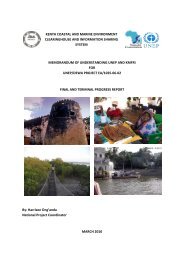
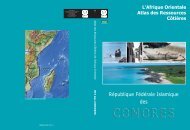
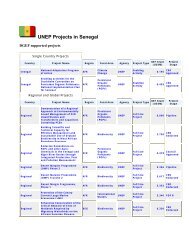

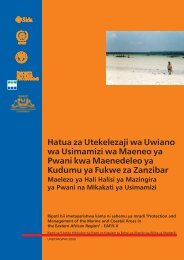
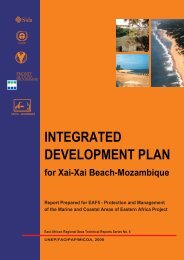
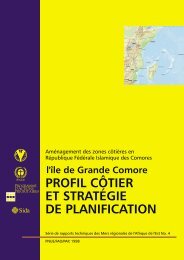
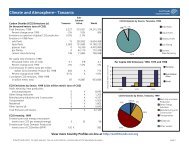

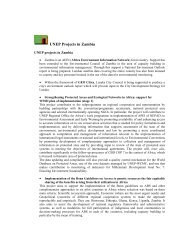
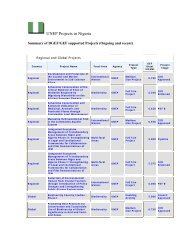
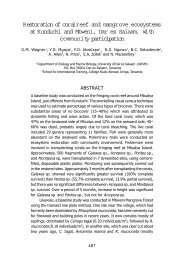
![Please Click to download [English] - GRID Africa GeoPortal - UNEP](https://img.yumpu.com/30633391/1/184x260/please-click-to-download-english-grid-africa-geoportal-unep.jpg?quality=85)
